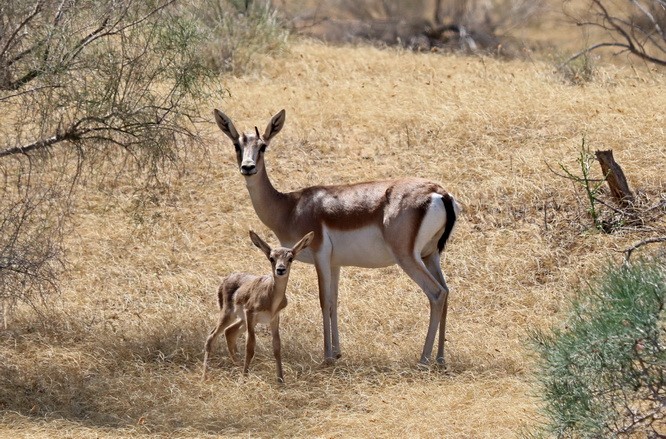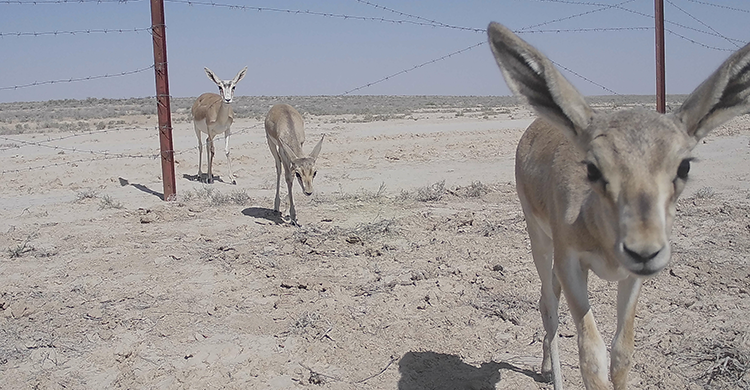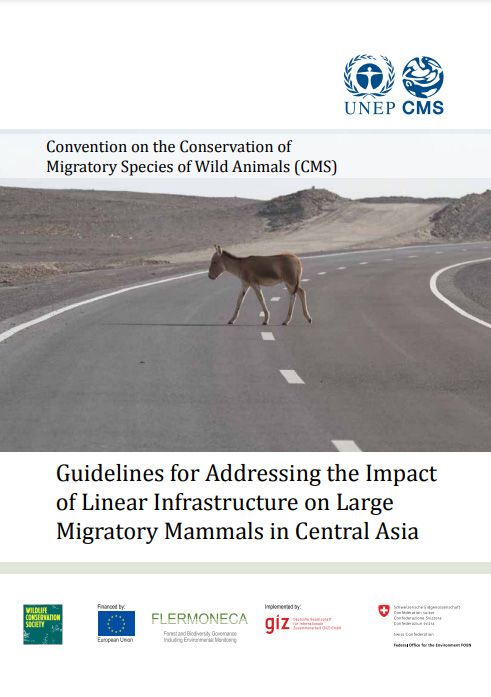IUCN Report Makes Recommendations for Re-Connecting Key Transboundary Habitat of Goitered Gazelles

Female gazelle with an offspring © Zh. Nurmuhambetov
Authors: Til Dieterich, Mark Pestov, Zhaskairat Nurmukhambetov, Vladimir Terentyev.
An expedition funded by the IUCN’s Save Our Species Central Asia initiative examined key transboundary habitats of Goitered Gazelles in the arid regions along Kazakhstan's southwestern border. The Goitered or black-tailed gazelle (Gazella subgutturrosa) has a wide distribution range, covering about 20 countries, in the Arabian Peninsula across the Middle East and Asia to Kazakhstan, Mongolia, China and Pakistan. The species is classified as vulnerable as its populations have declined in recent decades due to poaching, habitat degradation and fragmentation. Goitered gazelles migrate seasonally covering up to 30km per day.
The gazelle is one of the focus species of the IUCN’s Save Our Species Central Asia, which supports the implementation of the CAMI Programme of Work. The expedition took place in April-May 2021 in the frame of the project "Facilitating habitat connectivity and access to key resources for Goitered Gazelle populations in southern Kazakhstan" funded by Save Our Species Central Asia. It was organized by the Association for the Conservation of Biodiversity of Kazakhstan (ACBK) and had the following objectives:
- Rapid assessment of the presence of Goitered Gazelle populations along the state border of Kazakhstan;
- Assessment of the presence and design features of fencing in different sections of the state border of Kazakhstan and neighboring states Turkmenistan and Uzbekistan;
- Development of recommendations to minimize the negative impact of border fencing on gazelles and other ungulates.
The route of the expedition was over 2000km long, covering 1400km of Kazakhstan’s border with Turkmenistan and Uzbekistan. It stretched from the Caspian Sea in the west to the Syrdarya River in the east and crossed four regions of Kazakhstan - Mangistau, Aktobe, Kyzylorda and Turkestan. In some locations movement along the border was not possible, for example, due to the presence of large salt marshes or high sand dunes of up to 15 meters (part of Kyzylkum desert). The presence of gazelles was confirmed at 184 localities via sighting information and observed gazelle traces.
The expedition confirmed two transboundary habitats of key importance for the Goitered gazelle, according to the estimated number of animals using these habitats. As border fences cross these areas, it was recommended to modify them in order to provide gazelles with access to vital resources and to reduce animal mortality due to being trapped in the fences. The habitat locations are: 1) the southern part of the Ustyurt plateau (Mangistau region), where Kazakhstan borders Turkmenistan and Uzbekistan; 2) the Kyzylkum desert in Kyzylorda region near the Uzbekistan-Kazakhstan border which extends to the northern part of Kazakhstan’s Turkestan region.
The following observations were made in the study area with respect to obstacles for transboundary movements of ungulates: the entire surveyed state border of 1400km is fenced on the Kazakhstan side. This fence construction is a nearly complete obstacle for gazelles, except in places where there are special wildlife passages. It should be noted that on the border of Kazakhstan with Turkmenistan, fences are present on both sides and are a complete barrier for ungulates, while on the Kazakhstan-Uzbekistan border, wired fencing was present only on the Kazakhstan side.

Fig. 1 Track of the zoological expedition along the southern state border of Kazakhstan in April-May 2021 (blue line).
The southern part of the Ustyurt plateau (northwards to about 44˚N) is a key habitat for the gazelle located in Mangistau region, where Kazakhstan borders Turkmenistan and Uzbekistan. Here, along the border with Turkmenistan, cases of gazelles dying while trying to cross the fencing were observed already in a 2019 expedition and to date the problem remains unresolved. The expedition members suggest it is necessary to close the passages through which gazelles enter the deadly trap - the narrow (about 100 m) space between the wire fences on the Kazakhstan and Turkmenistan sides. The expedition members highly recommended that Ministries of Foreign Affairs of Kazakhstan and Turkmenistan discuss this issue. As habitat connectivity is at the heart of CMS mandate, given by its Parties, including all three countries (Kazakhstan, Uzbeksitan and Turkmenistan), the CMS Secretariat stands ready to assist the Parties in addressing the issue, if requested.
In addition, expedition members recommended to remove the fencing on the Kazakhstan side of the border section with Turkmenistan along the Kaplankyr chink (about 69 km long), as this area was critical for both Goitered Gazelles and the Urial (Ovis vignei). This section of the border was almost inaccessible for humans and land vehicles due to steep slopes of up to 150 m in height.
In the southern border section of Kazakhstan with Uzbekistan (about 133 km), adjacent to the South Ustyurt National Park established in Uzbekistan in 2020 (1.4 million ha), it was also recommended to remove 4-5 lower rows of fencing along its entire length- this will allow transboundary migration not only of gazelles but also of Asiatic Wild Ass (Kulan), inhabiting the adjacent territory of Uzbekistan.
On the remaining part of fencing along the Uzbeksitan border (about 205 km), where gazelles were also observed, construction of small passages of 2-3 fence sections (8-12 m) at intervals of 1-2 km was recommended.
In Aktobe region, only a small Saiga population (Saiga tatarica) currently inhabited the North Ustyurt and used to migrate regularly from Kazakhstan to Uzbekistan. At the border between Kazakhstan and Uzbekistan, a single 11.5 km long passageway for saiga had been constructed in the fencing: five lower rows of wire have been removed along its entire length. This section can be considered as a reference model for modifying the fence to ensure cross-border migrations of ungulates.

Fig. 2 Passage for migrating saiga in Aktobe region, about 11 km long, was constructed in the border section of KZ with UZ: the lower five rows of barbed wire have been removed. © T. Dieterich.
In the Kyzylorda region, research results confirmed that the Kyzylkum area is the most important habitat for the transboundary gazelle population. The presence of fencing on the Kazakhstan side along the border with Uzbekistan was a serious limiting factor for the transboundary gazelle movement: there were only two passages for ungulates in fencing, about 2 and 0.5 km long, identified in a stretch of about 308 km, which was not sufficient given the intensive use of the area by species.
In the areas where intensive seasonal use of the habitat is shown by the gazelle trails along the fence, (total length - about 180 km), 4-5 lower rows of wire should be removed at sections of 8-12 m with intervals of 1 km. In other sections where single tracks of gazelles were recorded (a total length of about 360 km), including sections of the border that we have not surveyed, the interval between openings in the fence could be increased to 2-3 km.
Within Turkestan region, traces of gazelles were found only in the northern section of the border (about 40 km) adjacent to Kyzylorda region, where there are no livestock or the resident population. Therefore, provision of passages through the fencing is relevant only for this border section.
Proposed measures to provide passages in border fencing for migratory ungulates were not unique: this solution was successfully applied at the Kazakhstan-Uzbekistan border section in Aktobe region to enable cross-border migrations of Saiga population and, in part, in Mangistau and Kyzylorda regions. At the same time, the experts taking part in the expedition suggested that proposed measures would not reduce the effectiveness of the fencing in preventing illegal vehicle crossings and would not affect the overall security of the border area of Kazakhstan. They plan to submit the results of the study and recommendations for consideration of the Government of Kazakhstan.
Link to the original report in Russian:
Last updated on 06 May 2022




